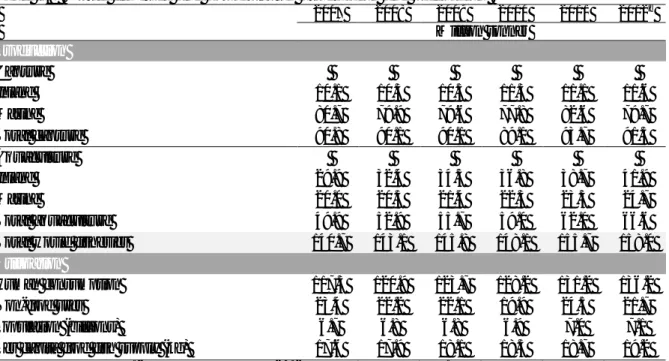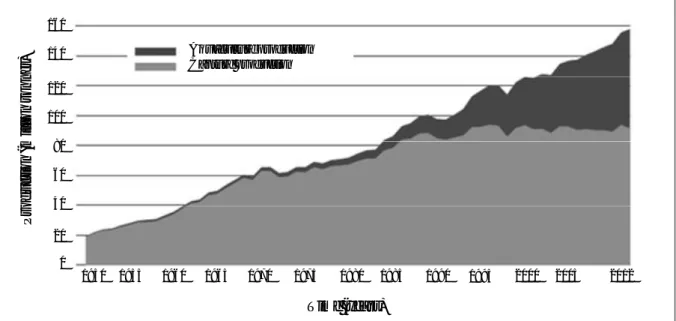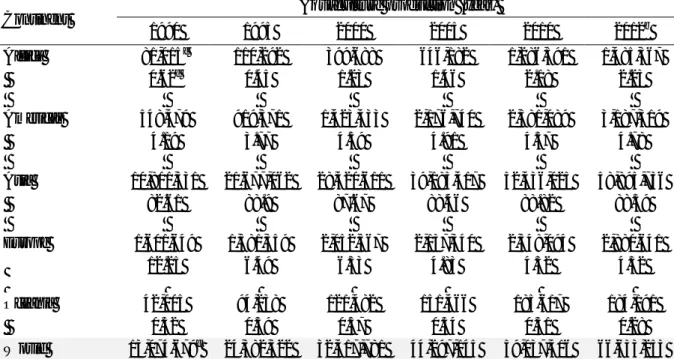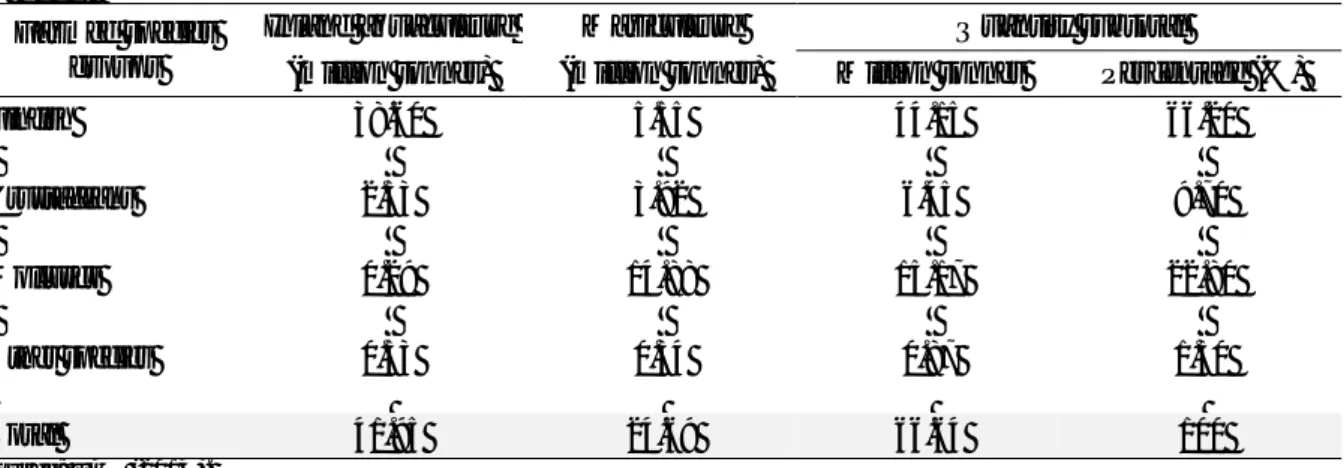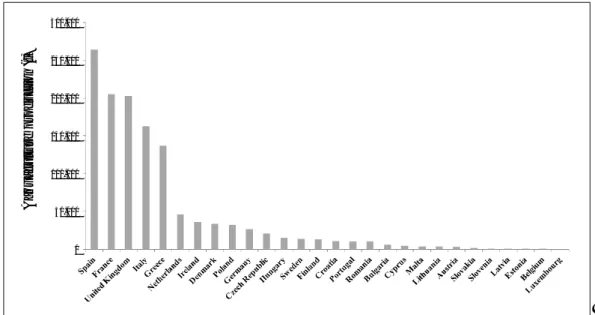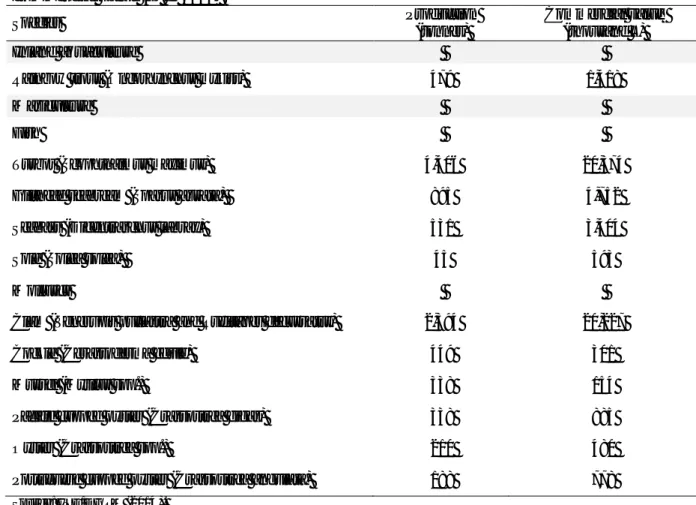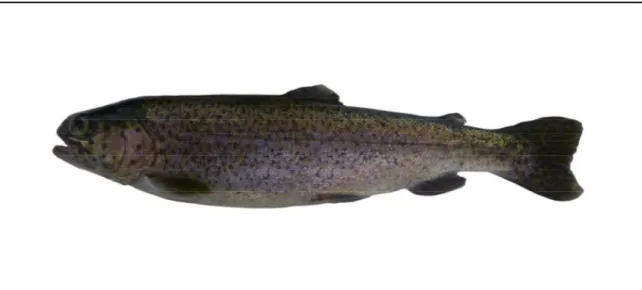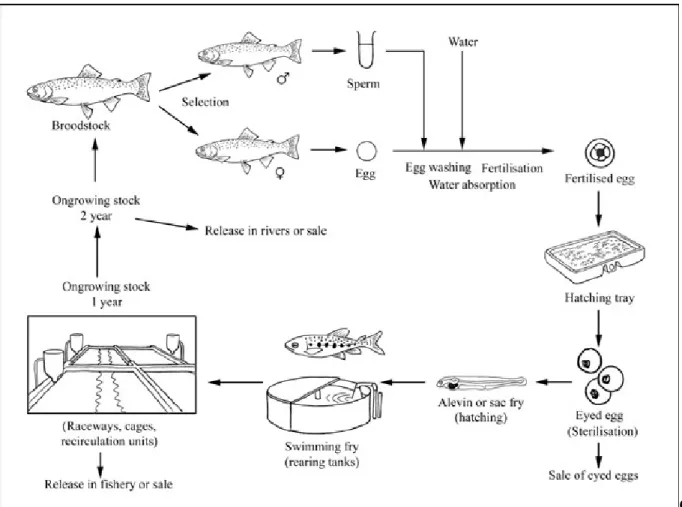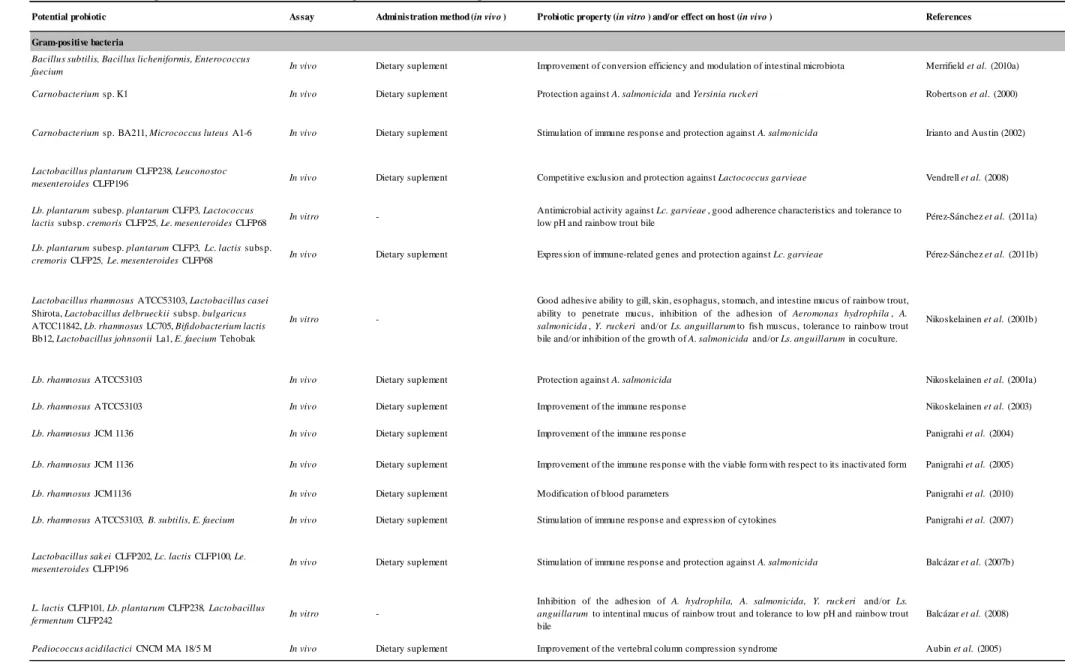Probiotic potential of lactic acid bacteria isolated from
rainbow trout (Oncorhynchus mykiss, Walbaum)
and rearing environment.
Importance in the prevention of fish diseases and public health
PhD Thesis in
Technologic, Comparative and Molecular Genetics
Carlos Alexandre Dias Araújo
Supervisors: Prof. Dr. Gilberto Paulo Peixoto Igrejas
Prof. Dr. Patrícia Alexandra Curado Quintas Dinis Poeta Prof. Dr. Luis Miguel Cintas Izarra
Probiotic potential of lactic acid bacteria isolated from
rainbow trout (Oncorhynchus mykiss, Walbaum)
and rearing environment.
Importance in the prevention of fish diseases and public health
PhD Thesis in
Technologic, Comparative and Molecular Genetics
Carlos Alexandre Dias Araújo
Supervisors: Prof. Dr. Gilberto Paulo Peixoto Igrejas
Prof. Dr. Patrícia Alexandra Curado Quintas Dinis Poeta Prof. Dr. Luis Miguel Cintas Izarra
JURY COMPOSITION:
Prof. Dr. Luís Herculano Melo de Carvalho Prof. Dr. Imanol Ruiz-Zarzuela Prof. Dr. Ana Maria Pereira Gomes Prof. Dr. Pedro Nuno Simões Rodrigues
Prof. Dr. Francisco José de Vasconcelos Leite Vieira e Brito Prof. Dr. Luis Miguel Cintas Izarra
Prof. Dr. Gilberto Paulo Peixoto Igrejas
This thesis was specifically prepared to obtain the PhD degree in Technologic, Comparative and Molecular Genetics.
Financial support provided by FCT (“Fundação para a Ciência e a Tecnologia”) and POPH-QREN/FSE (“Programa Operacional
Potencial Humano-Quadro de Referência Estratégico
Nacional/Fundo Social Europeu”, PhD grant
SFRH/BD/62416/2009).
The presented doctrines are the exclusive responsibility of the author.
The partial reproduction of this thesis is authorized only for research purposes, by written declaration of the person concerned, who commits to do so.
University of Trás-os-Montes and Alto Douro, _____/_____/_______
“Somewhere, something incredible is waiting to be known”
To my parents and siblings To Estefanía
ACKNOWLEDGMENTS
The PhD. journey is a process of learning, which is not possible without the help and support of other people. I would like to acknowledge everybody who have allowed, participated or contributed to the realization of this thesis; without them, I would not be able to complete my PhD. Therefore, I would like to sincerely and briefly express my gratitude to them.
Institutionally, I would like to recognize Professor António Augusto Fontaínhas Fernandes, Rector of the University de Trás-os-Montes e Alto Douro, and the Department of Veterinary Sciences, the Department of Genetics and Biotechnology, and the Veterinary and Animal Science Research Center of this University, as well as Professor María Dolores Selgas Cortecero, Director of the Department of Nutrition, Bromatology and Food Technology (Faculty of Veterinary Medicine, Complutense University of Madrid, Spain) and Professor Faustino Manuel Gascón Pérez, Director of the Department of Animal Pathology (Faculty of Veterinary Medicine, University of Zaragoza, Spain), for their willingness to provide the best conditions for the development and realization of this work.
To Fundação para a Ciência e a Tecnologia (FCT) and Programa Operacional Potencial Humano/Fundo Social Europeu (POPH/FSE) for the financial support.
To Professor Gilberto Igrejas, as my advisor, I would like to express my sincere admiration and gratefulness for his advice and guidance. I am also thankful for his invaluable
help andfeedbacks on this thesis.
To Professor Patrícia Poeta, as my co-advisor, I would like to thank for the constant encouragement, guidance and precious advice during my entire scientific career and my personal life.
To Professor Luis M. Cintas Izarra, my co-advisor from the Complutense University of Madrid (Spain), I would like to extend my deepest gratitude for encouraging my research and allowing me to grow as a scientist. I am also thankful for granting me the opportunity to perform the most of this research under his excellent guidance and for all the ideas and discussions about the themes involved in this doctoral thesis.
To Professor Carmen Herranz Sorribes, I would like to express thankfulness for the invaluable help and technical advice whenever required. Moreover, I would like to thank for her helpful suggestions and comments in the manuscripts resulting from this work.
To Professor Pablo E. Hernández, I would like to thank for accepting me in his lab, for the encouraging and relaxed working atmosphere, and for always having time to give valuable advice.
To all Professors from the Department of Nutrition, Bromatology and Food Technology (Faculty of Veterinary Medicine, Complutense University of Madrid, Spain), specially to Charo, Teresa, Juan Miguel and María, for their kindness to me during these years. And also, to Aurora, Santiago, Andrés, Alberto and Rosi for their friendliness.
To Professor José Luis Múzquiz, Professor Imanol Ruiz Zarzuela and Dra. Tania Pérez-Sánchez, from the Laboratory of Fish Diseases (University of Zaragoza, Spain) not only for supervising my research work during my stay, but also for helping me at every moment and for making my stay the most enjoyable. In addition, I would like to thank to Dr. Daniel Vendrell and Mamen Uriel for their technical assistance and expertise. I would also like to thank Hector, Nacho, Ana, Nabil, Olivia, Jorge, Jesús and Rafa for the pleasant moments we shared together during my stay.
To all the colleagues that worked alongside with me at “punto LAB” at Complutense University of Madrid (Spain), I would like to express my gratitude. Loreto, Cris, Bea, Juanjo, and Juan, thanks for your friendship and all the great moments we spent together inside and outside the lab. Thanks the colleagues from the “laboratorio del fondo” and from the “laboratorio de al lado”, Miguel Ángel, Nico, Alicia, Inés, María, Rebeca, Esther, Nivia, and Virginia, I have really appreciated getting to know and enjoy great moments with all of you. A warmly thanks Sara and Silvia, not just for all the help, jokes, and scientific discussions, but also for the dinners, “cañas”, trips that we enjoyed together, and for the Mexican birthday by surprise that I will never forget. Moreover, I would like to acknowledge my South-American friends, Yanina and Agustin, for their support via internet even being far away, they were always thoughtful.
To all the colleagues from different Departments at University de Trás-os-Montes e Alto Douro, I would like to acknowledge them. Specially, I would like to thank Alex for all the bureaucratic issues that you solved in my absence and for the truly companionship that you always showed. I would also like to thank Hajer, Susana and Luis Pinto for their encouragement and kindness.
To all the friends I have all around the world, I would like to deeply thank, specially to Leninha and Carlitos for taking me in their home every time I needed, for the enjoyable moments we spent together and for their long-time friendship.
To my family, I would like to express my deepest gratitude to them. My mother Hermínia, my father António and my siblings Sérgio and Fátima, thank you very much for trying to comprehend this long journey, only with your support, encouragement and love, this work became true. I would also like to acknowledge Cory and Julián, for keeping pushing me forward with this work, as well as Mario, with his wisdom, Judith, Pilar, Marisol, Maricruz, Paco, Rafa, Dani and little Mario.
Finally, to my dearest Estefanía, I would like to express my unlimited appreciation for supporting me through this work, for reading drafts of the manuscripts and this thesis, and for listening to me with infinite patience. I am truly thankful for your understanding along the years of this study, for all the weekends we sacrificed, and for the endless hours spent in front of our computers, always with positivity, which I never lost due to you. I am grateful for having you by my side during this complex stage of my life, which I hope that we remember as the beginning of something legendary for us.
v v
Graphical abstract
Lactic acid
bacteria isolation
and identification
Direct
antimicrobial
activity
Safety
assessment
Genetic
relatedness
Bacteriocin
characterization
Functional
properties
In vivo
evaluation
PROBIOTIC
STRAIN
100 90 80 70 0 10 20 30 40 60 50 7020 5776 4532 3288 2044 800 9,300 % I nte nsit y Mass (m/z) 3330.75 3362.98 3330.47 3148.43ABSTRACT
Aquaculture is the fastest-growing food-producing sector worldwide and an important economic activity in many countries, contributing to the increasing demand for food of aquatic origin. The use of lactic acid bacteria (LAB) as probiotics constitutes an alternative to chemotherapy and vaccination to control fish diseases in aquaculture, including lactococcosis caused by Lactococcus garvieae.
In Chapter 1, the cultivable total microbiota (TM) and LAB from rainbow trout and rearing environment from selected stages of the life-cycle was isolated and taxonomically identified. Enterobacteriaceae and Aeromonadaceae were clearly prevalent in the TM while the genus Lactococcus was the predominant LAB. From a total of 1,620 randomly selected LAB, 1,159 isolates (71.5%) showed antimicrobial activity against the main fish pathogens, including 248 isolates (21.4%) that showed antimicrobial activity against, at least, four fish pathogens. The taxonomical identification revealed that Lactococcus lactis was the most common species (164 isolates, 66.1%).
The safety assessment, genetic relatedness and bacteriocinogenic activity of 75 potential probiotic Lc. lactis strains were evaluated in Chapter 2. Moreover, the biochemical and genetic characterization of the bacteriocin most active against lactococcosis was performed. Seventeen strains (22%) produced, at least, one biogenic amine, and 30 strains (40%) showed resistance to, at least, one antibiotic. The genes tet(K), tet(O) and tet(T) were detected for the first time in Lc. lactis. Hemolysin and gelatinase production, mucin degradation and bile salts deconjugation were not found. ERIC-PCR allowed clustering the lactococci in three highly divergent groups (31.0% similarity). Nine strains (12%) were identified as bacteriocin producers and the purification, mass spectrometry and DNA sequencing of the bacteriocin produced by Lc. lactis subsp. cremoris WA2-67 revealed its identity to nisin Z (nisZ). Thirty four putatively safe lactococci (45.3%) were identified, including the bacteriocinogenic strain
Lc. cremoris WA2-67.
In Chapter 3, the safety assessment, genetic relatedness and bacteriocinogenic activity of eight Pediococcus acidilactici strains isolated from rainbow trout feed and larvae were evaluated. Furthermore, the biochemical and genetic characterization of the bacteriocin produced by the strain more interesting for being used as probiotic in aquaculture was performed. None of the pediococci showed antibiotic resistance nor produced hemolysin or gelatinase, degraded gastric mucin or deconjugated bile salts, and only four strains produced
tyramine or putrescine. ERIC-PCR allowed clustering the pediococci in two well-defined groups (68.0% similarity). Six strains (75%) were identified as bacteriocin producers and the bacteriocin produced by P. acidilactici L-14 was purified, and mass spectrometry and DNA sequencing revealed its identity to pediocin PA-1. Four putatively safe pediococci (50%) were identified, including the bacteriocinogenic P. acidilactici L-14.
In Chapter 4, the taxonomical identification, safety assessment and antimicrobial activity against fish pathogens of 64 enterococci isolated from rainbow trout, feed and rearing environment were evaluated. Enterococcus faecium and Enterococcus hirae were the most common species (42.2 and 35.9%, respectively). Forty-eight strains (75%) showed phenotypic resistance to, at least, one antibiotic, and from these, 25 strains (39.1%) harbored, at least, one antibiotic resistance gene [erm(B), tet(M), tet(S), tet(K), tet(L), tet(T), vanC2, and aad(E)]. Gelatinase production was detected in one strain; however, hemolysin production, bile salts deconjugation and mucin degradation were not detected. Several virulence genes were detected, including gelE (46.9%), efaAfs (17.2%), agg (1.6%), and hyl (1.6%). Forty-eight strains exerted antimicrobial activity against, at least, one of the tested fish pathogens, including 21 (43.8%) strains harboring, at least, one bacteriocin-encoding gene (entP,
entL50A and entL50B, hirJM79, entSE-K4, entQ and entA). From a total of 17 enterococci
(26.6%) considered as putatively safe, six strains harbored, at least, one bacteriocin-encoding gene.
The in vitro probiotic properties of three bacteriocinogenic Lc. cremoris, the in vivo ability of Lc. cremoris WA2-67 to protect rainbow trout against lactococcosis infection and the role of NisZ production as an anti-infective mechanism were evaluated in Chapter 5. The three Lc. cremoris showed ability to survive/tolerate the freshwater, acidic and bile environment, and different cell surface hydrophobicity (37.93–58.52%). The wild-type NisZ-producer Lc. cremoris WA2-67 and its non-bacteriocinogenic mutant Lc. cremoris WA2-67 ∆nisZ were administered orally to rainbow trout for 21 days and, afterwards, fish were challenged with Lc. garvieae by the cohabitation method. The fish fed with the bacteriocinogenic strain Lc. cremoris WA2-67 reduced significantly (p<0.01) the mortality (20%) compared to the fish treated with its non-bacteriocinogenic knockout isogenic mutant (50%) and the control (72.5%).
This thesis showed that host-derived LAB active against fish pathogens comprise potential candidates as probiotics in rainbow trout farming. Our results suggest that the
wild-type NisZ-producer strain Lc. cremoris WA2-67 could be used in fish farming to prevent lactococcosis in rainbow trout.
Keywords: Aquaculture; Rainbow trout (Oncorhynchus mykiss, Walbaum); Lactococcosis;
RESUMO
A aquicultura é um dos sectores alimentares que tem crescido mais rapidamente em todo o mundo. Sendo uma atividade económica importante em muitos países contribuiu para o aumento da procura de alimentos de origem aquática. A utilização de bactérias ácido-lácticas (LAB) como probióticos constitui uma alternativa aos antibióticos e à vacinação no controlo das doenças dos peixes de aquicultura, incluindo a lactococose causada por Lactococcus
garvieae.
No Capítulo 1, a microbiota cultivável total (TM) e as LAB de truta arco-íris e do seu ambiente aquícola, em diferentes estados do ciclo de vida, foram isoladas e identificadas taxonomicamente. Enterobacteriaceae e Aeromonadaceae foram prevalentes na TM, enquanto o género Lactococcus foi a LAB predominante. De um total de 1620 LAB selecionadas aleatoriamente, 1159 isolados (71,5%) apresentaram atividade antimicrobiana contra os principais patógenos de peixes, incluindo 248 isolados (21,4%) que apresentaram atividade antimicrobiana contra, pelo menos, quatro patógenos de peixes. A identificação taxonómica revelou que Lactococcus lactis foi a espécie mais comum (164 isolados, 66,1%).
A inocuidade, a relação genética e a actividade bacteriocinogénica de 75 estirpes de Lc.
lactis com potencial probiótico foram avaliadas ao longo do Capítulo 2. Adicionalmente, a
bacteriocina mais ativa contra a lactococose foi caracterizada ao nível bioquímico e genético. Dezassete estirpes (22%) produziram, pelo menos, uma amina biogénica, e 30 estirpes (40%) foram resistentes contra, pelo menos, um antibiótico. Os genes tet(K), tet(O) e tet(T) foram detetados pela primeira vez em Lc. lactis. A desconjugação dos sais biliares, produção de gelatinase e hemolisina tal como a degradação da mucina não foram observados. ERIC-PCR permitiu agrupar os lactococcos em três grupos altamente divergentes (31,0% de similaridade). Nove estirpes (12%) foram identificadas como produtoras de bacteriocinas e mediante purificação, espectrometria de massa e sequenciação de DNA da bacteriocina produzida por Lc. lactis subsp. cremoris WA2-67, foi possível identificar esta bacteriocina como nisina Z (nisZ). Trinta e quatro lactococos supostamente inócuos (45,3%) foram identificados, incluindo a estirpe bacteriocinogénica Lc. cremoris WA2-67.
No Capítulo 3 foram estudadas a inocuidade, a relação genética e a atividade bacteriocinogénica de oito estirpes de Pediococcus acidilactici isoladas da ração e de larvas de truta arco-íris. Além disso, a bacteriocina produzida pela estirpe mais ativa para ser utilizada como probiótico na aquicultura foi caracterizada ao nível bioquímico e genético.
Nenhum dos pediococos foi resistente aos antibióticos, produziu hemolisina ou gelatinase, degradou a mucina gástrica ou desconjugou os sais biliares, ainda que apenas quatro estirpes produziram tiramina ou putrescina. ERIC-PCR permitiu agrupar os pediococos em dois grupos bem definidos (68,0% de similaridade). Seis estirpes (75%) foram identificadas como bacteriocinogénicas e mediante purificação, espectrometria de massa e sequenciação de DNA da bacteriocina produzida por P. acidilactici L-14 foi possível identificar esta bacteriocina como pediocina PA-1. Quatro pediococos supostamente inócuos (50%) foram identificados, incluindo a estirpe bacteriocinogénica P. acidilactici L-14.
No decorrer do Capítulo 4, estudou-se a inocuidade e atividade antimicrobiana contra patógenos de 64 enterococos identificados taxonomicamente isolados de truta arco-íris, ração e ambiente aquícola. Enterococcus faecium e Enterococcus hirae foram as espécies mais comuns (42,2 e 35,9%, respetivamente). Quarenta e oito estirpes (75%) foram fenotipicamente resistentes a pelo menos um antibiótico. Deste conjunto, 25 estirpes (39,1%), continham, pelo menos, um gene de resistência a antibióticos [erm(B), tet(M), tet(S), tet(K),
tet(L), tet(T), vanC2 e aad(E)]. Detetou-se uma estirpe gelatinase positiva, e não se observou
a produção de hemolisina, desconjugação de sais biliares e degradação de mucina. Vários genes de virulência foram detetados, incluindo gelE (46,9%), efaAfs (17,2%), agg (1,6%), e
hyl (1,6%). Quarenta e oito estirpes inibiram o crescimento de, pelo menos, um dos patógenos
de peixes testados, incluindo 21 (43,8%) estirpes que continham, no mínimo, um gene que codifica bacteriocina (entP, entL50A and entL50B, hirJM79, entSE-K4, entQ and entA). De um total de 17 enterococos (26,6%) considerados como supostamente inócuos, seis estirpes continham, pelo menos, um gene que codifica bacteriocina.
As propriedades probióticas in vitro de três estirpes Lc. cremoris bacteriocinogénicas, a capacidade in vivo de Lc. cremoris WA2-67 para proteger a truta arco-íris contra a lactococose e o papel da produção de NisZ como um mecanismo anti-infeccioso foram analisadas no Capítulo 5. As três estipes de Lc. cremoris mostraram capacidade para sobreviver em água doce, meio ácido e bílis, e exibiram diferente hidrofobicidade da superfície celular (37,93-58,52%). A estirpe selvagem Lc. cremoris WA2-67 e o seu mutante não-bacteriocinogénico Lc. cremoris WA2-67 ΔnisZ foram administrados oralmente à truta arco-íris durante 21 dias e, posteriormente, os peixes foram infetados com Lc. garvieae pelo método de coabitação. A mortalidade observada nos peixes alimentados com a estirpe bacteriocinogénica Lc. cremoris WA2-67 (20%) foi significativamente (p <0,01) inferior à observada nos peixes tratados com a estirpe mutante (50%) e no grupo controlo (72,5%).
Neste trabalho demonstrou-se que as LAB isoladas diretamente do hospedeiro, ativas contra patógenos de peixes, englobam potenciais candidatos a probióticos. Os resultados obtidos através da avaliação biotecnológica sugerem que a estirpe Lc. cremoris WA2-67 produtora de NisZ poderia ser utilizada na aquicultura para evitar a lactococose na truta arco-íris.
Palavras-chave: Aquicultura; Truta arco-íris (Oncorhynchus mykiss, Walbaum); Lactococose; Probióticos; Bactérias ácido-lácticas; Produção de bacteriocina; Biotecnologia.
LIST OF ABBREVIATIONS
A Absorbance
aad(E) Streptomycin resistant gene
ABC Adenosine Triphosphate Binding Cassette
AD Arginine deiminase
ADC Arginine decarboxylase
ADT Agar Diffusion Test
AGD Agmatine deiminase
agg Aggregation substance gene
APROMAR Spanish Association of Producers of Marine Aquaculture (Asociación
Empresarial de Productores de Cultivos Marinos de España)
ATCC American Type Culture Collection
AXOS Arabinoxylan-oligosaccharides
BLAST Basic Local Alignment Search Tool
bp Base pairs
cat(A) Chloramphenicol acetyltransferase gene
CECT Spanish Type Culture Collection (Colección Española de Cultivos Tipo)
cfu Colony forming unit
CHL Chloramphenicol
CIP Ciprofloxacin
CK Carbamate kinase
CLIN Clindamycin
COS Chito-oligosaccharides
cylLL-cylLS Cytolysin precursor genes
cylM Cytolysin posttranslational modifier gene
Da Dalton
DGRM Directorate General for Natural Resources, Safety and Maritime Services (Direção Geral de Recursos Naturais, Segurança e Serviços Marítimos)
DNA Deoxyribonucleic acid
DPH Days post-hatching
EC European Commission
ef1097 Enterococcin V583 gene
efaAfs Enterococcus faecalis endocarditis antigen gene
EFSA European Food Safety Authority
ent Enterocin gene
EPS Exopolysaccharides
ere Erythromycin esterase gene
ERIC-PCR Enterobacterial Repetitive Intergenic Consensus PCR
erm Erythromycin resistant gene
ERY Erythromycin
esp Extracellular surface protein gene
FAO Food and Agriculture Organization of the United Nations
FDA Food and Drug Administration
FEEDAP Panel on Additives and Products or Substances used in Animal Feed
FOS Fructooligosaccharides
gelE Gelatinase gene
GEN Gentamicin
GOS Galactooligosaccharides
GRAS Generally Recognized as Safe
G+C Guanine and cytosine content (mol%)
HDC Histidine decarboxylase
hirJM79 Hiracin JM79 gene
HPLC High Performance Liquid Chromatography
hyl Putative glycosyl hydrolase gene
IL-1β Interleukin-1β
IL-8 Interleukin-8
INE Statistics Portugal (Instituto Nacional de Estatística)
IS Insertion Sequence
JIP Jouy-en-Josas strain collection
KAN Kanamycin
kb Kilobase kDa Kilodalton
kg Kilogram
L Litres
LAB Lactic acid bacteria
lin Lincosamide resistant gene
LMG Laboratory of Microbiology Gent Bacteria Collection
mef(A/E) Macrolide efflux gene
mg Miligrams
MIC Minimum Inhibitory Concentration
MOS Mannan oligosaccharides
MRS Man, Rogosa and Sharpe
NACA Network of Aquaculture Centers in Asia-Pacific
NCIMB National Collections of Industrial, Marine and Food Bacteria
ng Nanograms
nis Nisin gene
NisA Nisin A
NisZ Nisin Z
OD Optical density
ODC Ornithine decarboxylase
PCR Polymerase Chain Reaction
PedPA-1 Pediocin PA-1
PFGE Pulsed-Field Gel Electrophoresis
pI Isoelectric point
PTC Putrescine carbamoyl transferase
Q-D Quinupristin-dalfopristin
QPS Qualified Presumption of Safety
rep-PCR Repetitive Element Sequence Based-PCR
RNA Ribonucleic acid
RP-FPLC Reversed-phase Fast-Protein Liquid Chromatography
rRNA Ribosomal RNA
SCAN Scientific Committee on Animal Nutrition
SOAT Stab-On-Agar Test
sodA Superoxide dismutase gene
SOFIA The State of World Fisheries and Aquaculture
STR Streptomycin
t Tonnes
TDC Tyrosine decarboxylase
TET Tetracycline
tet Tetracycline resistant gene
TM Total microbiota
TNF Tumoral Necrosis Factor
TSA Tryptic Soya Agar
TSB Tryptic Soya Broth
VAN Vancomycin
vat Quinupristin-dalfopristin resistant gene
WHO World Health Organization
LIST OF ABBREVIATIONS OF MICROBIAL GENUS A. Aeromonas spp. Al. Aliivibrio spp. B. Bacillus spp. C. Carnobacterium spp. Cl. Clostridium spp. D. Debaryomyces spp.
E. Enterococcus spp. (occasionally Escherichia spp., e.g. E. coli)
Ed. Edwardsiella spp. F. Flavobacterium spp. L. Listeria spp. Lb. Lactobacillus spp. Lc. Lactococcus spp. Le. Leuconostoc spp. Ls. Listonella spp. M. Mycobacterium spp. P. Pediococcus spp. Pc. Piscirickettsia spp. Ph. Photobacterium spp. Ps. Pseudomonas spp. R. Renibacterium spp. S. Saccharomyces spp. St. Streptococcus spp. T. Tenacibaculum spp V. Vibrio spp. Vg. Vagococcus spp. W. Weissella spp. Y. Yersinia spp.
TABLE OF CONTENTS
SECTION I – GENERAL INTRODUCTION ... 1
1. RESEARCH FOCUS ... 3 2. AQUACULTURE ... 5
2.1. Definition of aquaculture ... 5 2.2. Aquaculture methods ... 5 2.2.1. Extensive fresh water aquaculture ... 6 2.2.2. Intensive fresh water aquaculture ... 6 2.2.3. Extensive brackish water aquaculture ... 6 2.2.4. Aquaculture of marine species in shore-based installations ... 7 2.2.5. Marine cage aquaculture ... 7 2.2.6. Shellfish farming ... 7 2.3. The state of world fisheries and aquaculture... 7 2.3.1. World aquaculture production ... 8 2.3.2. Global aquaculture production distribution ... 9 2.3.3. Inland aquaculture, mariculture and species groups farmed... 10 2.3.4. Species produced in aquaculture ... 11 2.3.5. Farmed food fish production by leading producers ... 12 2.4. Aquaculture in the European Union ... 13 2.5. Aquaculture in Portugal ... 15 2.5.1. Main species production ... 16 2.5.1.1. Rainbow trout ... 16
3. BACTERIAL FISH DISEASES AND CONTROL MEASURES IN AQUACULTURE ... 18
3.1. Bacterial fish diseases ... 19 3.1.1. Bacterial fish diseases affecting the rainbow trout production ... 19 3.1.1.1. Lactococcosis ... 20 3.1.1.2. Streptococcosis ... 20 3.1.1.3. Bacterial kidney disease (BKD) ... 20 3.1.1.4. “Pseudo kidney disease” ... 21 3.1.1.5. Enteric red-mouth disease ... 21 3.1.1.6. Furunculosis ... 21 3.1.1.7. Rainbow trout fry syndrome (RTFS)... 21 3.1.1.8. Vibriosis... 22 3.2. Control measures ... 22 3.2.1. Antibiotics ... 22 3.2.2. Alternatives to the use of antibiotics ... 24
3.2.2.2. Probiotics ... 27 3.2.2.3. Prebiotics ... 27 3.2.2.4. Phage therapy ... 28 3.2.2.5. Other alternatives ... 28 4. PROBIOTICS IN AQUACULTURE ... 29 4.1. Definition of probiotics ... 29 4.2. Selection of probiotics ... 30 4.2.1. Safety assessment ... 31 4.2.2. Evaluation of the functional and probiotic properties (efficacy) ... 31 4.2.3. Evaluation of the technological characteristics ... 32 4.3. Action mechanisms of probiotics ... 32 4.3.1. Competitive exclusion ... 33 4.3.1.1. Production of antimicrobial compounds... 33 4.3.1.2. Competition by nutrients ... 33 4.3.1.3. Competition by the adhesion sites ... 34 4.3.2. Improvement of host nutrition ... 34 4.3.3. Modulation of the immune system ... 35 4.3.4. Improvement of water quality ... 35 4.3.5. Tolerance to stress ... 36 4.4. Factors affecting the efficacy of probiotics ... 36 4.4.1. Origin: indigenous vs. exogenous microorganisms ... 36 4.4.2. Viability: viable vs. non-viable microorganisms ... 37 4.4.3. Monoculture (monospecies) vs. mixed culture (multistrains/multispecies) ... 37 4.4.4. Dose of probiotics and duration of administration ... 38 4.4.5. Mode of administration ... 38 4.5. Microbial groups evaluated as probiotics in aquaculture ... 39 4.5.1. Gram-positive bacteria ... 39 4.5.2. Gram-negative bacteria ... 43 4.5.3. Yeasts ... 43
5. LACTIC ACID BACTERIA ... 44
5.1. General properties and taxonomy ... 44 5.2. Antimicrobial activity of lactic acid bacteria ... 45 5.2.1. Bacteriocins ... 46 5.2.1.1. Classification of bacteriocins... 46 5.2.1.2. Physicochemical properties ... 49 5.2.1.3. Antimicrobial spectrum ... 49 5.2.1.4. Purification ... 50 5.2.1.5. Mode of action ... 52 5.2.1.6. Biosynthesis and genetic organization ... 55 5.2.1.7. Biopreservative potential ... 58
5.3. Importance of lactic acid bacteria ... 59 5.3.1. Lactic acid bacteria and food ... 59 5.3.2. Negative aspects of the presence of lactic acid bacteria in food ... 60 5.3.3. Lactic acid bacteria and health ... 61 5.3.3.1. Lactic acid bacteria as probiotic cultures ... 61 5.3.3.2. Lactic acid bacteria as oral vaccines ... 62 5.3.3.3. Lactic acid bacteria as nutraceutical producer ... 62 5.3.4. Lactic acid bacteria and disease ... 63 5.4. Lactic acid bacteria evaluated as probiotics in aquaculture ... 64
5.4.1. Pediococcus acidilactici CNCM MA 18/5 (Bactocell®) ... 66
BIBLIOGRAPHY ... 69 OBJECTIVES ... 99
SECTION II – EXPERIMENTAL WORK ... 101
Chapter 1 – Inhibition of fish pathogens by the microbiota from rainbow trout (Oncorhynchus mykiss, Walbaum) and rearing environment ... 103
Abstract ... 105 1. Introduction ... 106 2. Materials and Methods ... 107 2.1. Sampling procedure and isolation of the microbiota ... 107 2.2. Screening for LAB with antimicrobial activity ... 108 2.3. Taxonomic identification of the microbiota ... 109 3. Results ... 110 3.1. Isolation and identification of the microbiota ... 110 3.2. Antimicrobial activity of LAB ... 111 3.3. Taxonomic identification of LAB ... 114 4. Discussion ... 115 5. Acknowledgments ... 120 6. References ... 121
Chapter 2 – Safety assessment, genetic relatedness and bacteriocin activity of potential probiotic Lactococcus lactis strains from rainbow trout (Oncorhynchus
mykiss, Walbaum) and rearing environment ... 125 Abstract ... 127 1. Introduction ... 128 2. Materials and Methods ... 130 2.1. Bacterial strains and growth conditions ... 130 2.2. Antibiotic susceptibility determination ... 130 2.3. PCR detection of antibiotic resistance genes ... 131 2.4. Biogenic amine production ... 132 2.5. Mucin degradation ... 134
2.6. Bile salt deconjugation ... 134 2.7. Hemolysin and gelatinase production ... 134 2.8. Enterobacterial Repetitive Intergenic Consensus PCR (ERIC-PCR) ... 135 2.9. Extracellular antimicrobial (bacteriocin) activity assay ... 135 2.10. Bacteriocin purification and mass spectrometry analysis ... 136 2.11. Nucleotide sequencing of the nisin Z gene cluster ... 137 3. Results ... 137 3.1. Safety assessment of the 75 Lc. lactis strains ... 137 3.2. Genetic profiling of the 75 Lc. lactis strains ... 141 3.3. Extracellular antimicrobial (bacteriocin) activity of the 75 Lc. lactis strains ... 141 3.4. Purification of the bacteriocin produced by Lc. cremoris WA2-67 ... 143 3.5. Genetic organization of the nisin Z gene cluster in Lc. cremoris WA2-67 ... 145 4. Discussion ... 145 5. Conclusions ... 150 6. Acknowledgments ... 151 7. References ... 152
Chapter 3 – Characterization of Pediococcus acidilactici strains from rainbow trout (Oncorhynchus mykiss, Walbaum) feed and larvae: safety, fingerprinting and bacteriocinogenicity approaches ... 159
Abstract ... 161 1. Introduction ... 162 2. Materials and Methods ... 163 2.1. Sampling procedure and LAB isolation ... 163 2.2. Bacterial strains and growth conditions ... 164 2.3. Direct antimicrobial activity assays ... 164 2.4. Taxonomic identification ... 165 2.5. Antibiotic susceptibility determination ... 165 2.6. Hemolysin production ... 166 2.7. Gelatinase production ... 167 2.8. Mucin degradation ... 167 2.9. Biogenic amine production ... 167 2.10. Bile salt deconjugation ... 168 2.11. Enterobacterial Repetitive Intergenic Consensus PCR (ERIC-PCR) ... 168 2.12. Extracellular antimicrobial (bacteriocin) activity assay ... 169 2.13. Bacteriocin purification and mass spectrometry analysis ... 169 2.14. Nucleotide sequencing of the PA-1 structural and immunity genes ... 170 3. Results ... 171 3.1. Isolation of LAB from rainbow trout feed and direct antimicrobial activity ... 171 3.2. Taxonomic identification ... 171 3.3. Safety assessment ... 172
3.4. Genetic profiling ... 173 3.5. Extracellular antimicrobial activity ... 173 3.6. Purification and genetic characterization of the bacteriocin produced by
P. acidilactici L-14 ... 174
4. Discussion ... 176 5. Conclusion ... 180 6. Acknowledgments ... 181 7. References ... 182
Chapter 4 – Evaluation of Enterococcus spp. from rainbow trout (Oncorhynchus
mykiss, Walbaum), feed, and rearing environment against fish pathogens ... 189 Abstract ... 191 1. Introduction ... 192 2. Materials and Methods ... 193 2.1. Samples and bacterial strains ... 193 2.2. Species identification ... 194 2.3. Antibiotic susceptibility ... 196 2.4. Gelatinase and hemolysin production ... 196 2.5. Bile salt deconjugation ... 196 2.6. Mucin degradation ... 197 2.7. Direct antimicrobial activity ... 197 2.8. PCR detection of antibiotic resistance genes, virulence genes and markers, and
bacteriocin structural genes ... 198 3. Results ... 199 3.1. Genotypic identification ... 199 3.2. Antibiotic susceptibility ... 199 3.3. Detection of antibiotic resistance genes ... 199 3.4. Gelatinase and hemolysin production, bile salt deconjugation, and mucin
degradation ... 201 3.5. Detection of virulence genes and markers ... 201 3.6. Direct antimicrobial activity and detection of bacteriocin structural genes ... 201 3.7. Safety aspects and antimicrobial activity of potential probiotic candidates ... 203 4. Discussion ... 203 5. Conclusions ... 206 6. Acknowledgments ... 206 7. References ... 208
Chapter 5 – Nisin Z production by Lactococcus lactis subsp. cremoris WA2-67 of aquatic origin as a defense mechanism to protect rainbow trout (Oncorhynchus
mykiss, Walbaum) against Lactococcus garvieae ... 211 Abstract ... 213 1. Introduction ... 214
2. Materials and Methods ... 216 2.1. Bacterial strains, growth conditions and plasmids ... 216 2.2. Survival in freshwater ... 216 2.3. Resistance to rainbow trout bile and low pH ... 217 2.4. Cell surface hydrophobicity ... 218 2.5. Construction of Lc. cremoris WA2-67 ΔnisZ isogenic strain ... 218 2.5.1. Molecular techniques and enzymes ... 218 2.5.2. Construction of the gene knockout plasmid ... 218 2.5.3. Knockout of nisZ ... 220 2.5.4. Extracellular antimicrobial (bacteriocin) activity assay ... 220 2.6. Preparation of the feed ... 221 2.7. Fish ... 221 2.8. Experimental conditions ... 222 2.9. Growth rate analysis ... 222 2.10. Challenge test ... 222 2.11. Statistical analysis ... 223 3. Results ... 223 3.1. Survival in freshwater ... 223 3.2. Resistance to rainbow trout bile and low pH ... 223 3.3. Hydrophobicity ... 224 3.4. Extracellular antimicrobial (bacteriocin) activity ... 225 3.5. Growth rate analysis ... 225 3.6. Challenge tests ... 225 4. Discussion ... 226 5. Acknowledgments ... 229 6. References ... 230 SECTION III – GENERAL DISCUSSION AND CONCLUDING REMARKS ... 235 General discussion ... 237
Bibliography ... 252 Concluding remarks and future prospects ... 261
LIST OF TABLES
Table I.1. World fisheries and aquaculture production and utilization ... 8 Table I.2. Aquaculture production by region: quantity (t) and percentage (%) of world
total production ... 10
Table I.3. World production of farmed species groups from inland aquaculture and
mariculture in 2012 ... 11
Table I.4. Portuguese production of the main farmed fish and mollusc species (t) and
their commercial value (€) in 2012 ... 16
Table I.5. Studies developed about the effect of different microorganisms as rainbow
trout probiotics ... 41
Table II.1. Taxonomic identification of the cultivable total microbiota (TM) and lactic
acid bacteria (LAB) from rainbow trout intestine and rearing environment (tank vegetation and water) from selected stages of the fish life-cycle ... 112
Table II.2. Antimicrobial activity of 1,620 LAB isolates grouped by origin and growth
stage against Gram-positive and Gram-negative fish pathogens ... 113
Table II.3. Oligonucleotide primers used in this study ... 133 Table II.4. MICs distribution of 10 antibiotics for the 75 Lc. lactis strains ... 138 Table II.5. Safety assessment of the 75 Lc. lactis strains ... 139 Table II.6. Extracellular (bacteriocin) antimicrobial activity of the 75 Lc. lactis strains ... 143 Table II.7. Purification of nisin Z produced by Lc. cremoris WA2-67 ... 144 Table II.8. Oligonucleotide primers used in this study ... 166 Table II.9. Direct antimicrobial activity against fish pathogens of the eight
P. acidilactici strains isolated from rainbow trout feed and larvae ... 171
Table II.10. MICs distribution of eight antibiotics for the eight P. acidilactici strains
isolated from rainbow trout feed and larvae ... 172
Table II.11. Safety assessment of the eight P. acidilactici strains isolated from rainbow
trout feed and larvae ... 172
Table II.12. Extracellular antimicrobial (bacteriocin) activity of the eight P. acidilactici
strains isolated from rainbow trout feed and larvae ... 174
Table II.13. Purification of PedPA-1 produced by P. acidilactici L-14 ... 175 Table II.14. Oligonucleotide primers used in this study ... 194 Table II.15. Safety assessment and bacteriocin genotype detected in the 64 Enterococcus
Table II.16. Antimicrobial activity of 64 enterococcal strains against the nine fish
pathogens tested ... 202
Table II.17. Bacterial strains and plasmids used in this study for nisin Z gene knockout .... 217 Table II.18. Primers and PCR products used in this study for nisin Z gene knockout ... 219 Table II.19. Ability of lactococcal strains to survive/tolerate the freshwater, acidic and
LIST OF FIGURES
Figure 1.1. World capture fisheries and aquaculture production for the period between
1950 and 2012. ... 9
Figure 1.2. World inland aquaculture and mariculture production for the period
between 1980 and 2012. ... 10
Figure 1.3. Aquaculture production (t) in the members countries of the EU in 2012 ... 14 Figure 1.4. Consumption of aquatic products per capita (kg) in the EU countries in
2009 ... 14
Figure 1.5. Specimen of rainbow trout ... 17 Figure 1.6. The production cycle of rainbow trout ... 18 Figure 1.7. Application of bacteriocin-producing strains and purified bacteriocins in
human and animal medicine and food industry ... 45
Figure 1.8. Modes of action proposed for bacteriocins. ... 53 Figure 1.9. Biosynthesis, immunity, and regulation of nisin A production ... 57 Figure 2.1. Average counts of cultivable total microbiota (TM) and lactic acid bacteria
(LAB) from aquacultured rainbow trout intestine and rearing environment (tank vegetation and water) from selected stages of the fish life-cycle ... 110
Figure 2.2. Relative percentages of Lc. lactis isolates with antimicrobial activity
against the four tested Lc. garvieae strains at each growth stage ... 115
Figure 2.3. Distribution of the 88 LAB isolates with antimicrobial activity against the
four tested Lc. garvieae strains by origin, growth stage and taxonomic identification ... 119
Figure 2.4. Antibiotic (multi)resistance phenotypes and genotypes amongst the 75
Lc. lactis strains ... 140
Figure 2.5. Distribution by safety assessment and growth stage of the 75 Lc. lactis
strains ... 140
Figure 2.6. Dendrogram and ERIC-PCR banding patterns of the 75 Lc. lactis strains .... 142 Figure 2.7. Reverse-phase chromatography of the bacteriocin secreted by Lc. cremoris
WA2-67 ... 143
Figure 2.8. Mass spectrometry analysis of purified nisin Z from Lc. cremoris WA2-67 . 144 Figure 2.9. Cluster analysis of ERIC-PCR fingerprinting of the eight P. acidilactici
Figure 2.10. Reverse-phase chromatography of the bacteriocin produced by
P. acidilactici L-14 ... 175
Figure 2.11. Mass spectrometry analysis of purified PedPA-1 from P. acidilactici L-14 .. 176 Figure 2.12. The schematic representation of nisZ knockout ... 219 Figure 2.13. Lc. cremoris cell surface hydrophobicity ... 224
Figure 2.14. Antimicrobial activity of supernatants from the wild-type
bacteriocinogenic strain Lc. cremoris WA2-67 and its non-bacteriocinogenic knockout mutant isogenic strain Lc. cremoris WA2-67 ∆nisZ against Lc. garvieae CLG4 as determined by an ADT ... 225
Figure 2.15. Mortality curves of rainbow trout challenged with Lc. garvieae CLG4 with
and without probiotic treatments (Lc. cremoris WA2-67 and Lc. cremoris WA2-67 ∆nisZ). ... 226
Figure 3.1. Relative percentages of the cultivable total microbiota at each growth stage 238 Figure 3.2. Relative percentages of LAB at each growth stage ... 239 Figure 3.3. Biogenic amine biosynthesis pathways in LAB ... 244 Figure 3.4. Schematic representation of pediocin PA-1 operon ... 248 Figure 3.5. Lactococcosis infection in farmed rainbow trout characterized by bilateral
1. RESEARCH FOCUS
Currently, the over-exploitation of the fishing sources and the lack of new fishing grounds seem to have reached the extractive fishing limit. Therefore, aquaculture has become the fastest-growing food-producing sector worldwide and is considered as the unique alternative to contribute to the increasing demand for food of aquatic origin (Defoirdt et al., 2011; FAO, 2010). The rainbow trout is a fish farmed species of worldwide commercial interest, being the fourth species produced in terms of weight and the fifth in terms of economical value in the European Union. Moreover, this is the only freshwater species cultivated in Portugal since 2012 (INE/DGRM, 2014). Although the modern aquaculture industry has expanded, diversified and intensified in the last years, the emergence of a large variety of pathogens represents a major limiting factor for this sector (Pérez-Sánchez et al., 2014). In this respect, the prevention and control of fish diseases, mainly those of bacterial origin during the larval and early fry stages, avoid important losses in the production (Almeida et al., 2009; Toranzo et al., 2005). In order to prevent and control fish diseases, the use of veterinary drugs, especially antibiotics, was frequently used in the last decades (Mohapatra et al., 2012); however, their widespread use has been associated with detrimental effects for the human and animal health, food safety and the environment, including the emergence of antibiotic resistances and the alteration of the aquaculture environment microbiota (Cabello, 2006; EFSA, 2008a; FAO, 2005; Muñoz-Atienza et al., 2013). Consequently, the majority of the developed countries have enforced very stringent regulations about the use of antibiotics in aquaculture, including the ban of antibiotics as prophylactic treatment, the reduction of authorized antibiotics, the control of the veterinary prescription, the establishment and surveillance of maximum residue limits and the prohibition of the use of certain antibiotics for their high toxicity or importance in human medicine and capability to induce antibiotic resistances (Cabello, 2006; EFSA, 2008a; 2008b; FAO, 2005). Furthermore, vaccination seems to represent the ideal control method to prevent fish diseases although its application may be hampered by several factors, such as availability, level of protection, economic cost, inefficacy in larval stages, growth delay, limitation in its efficacy when fish are infected by other pathogens or when immunostimulants are not used, alterations in product quality, and animal stress, especially when vaccines are administered by intraperitoneal injection with the consequent repercussion in their immune response and, consequently, in their productivity (EFSA, 2008b; Subasinghe, 2009; Toranzo et al., 2009). In this scenario, the use of lactic acid bacteria (LAB) of aquatic origin as probiotic cultures
constitutes an effective, safe, easy to apply, economically efficient and environmentally friendly alternative or complementary strategy to the chemotherapy and vaccination for disease control in the aquaculture farming (Balcázar et al., 2006; Defoirdt et al., 2011; Merrifield et al., 2010b; Nayak, 2010; Pérez-Sánchez et al., 2014; Ringø et al., 2010a; Verschuere et al., 2000b). Probiotics are defined as live microbial adjuncts which have a beneficial effect on the host by: (i) modifying the host-associated or ambient microbial community, (ii) improving feed use or enhancing its nutritional value, (iii) enhancing the host response towards disease, and/or (iv) improving the physico-chemical and microbiological quality of its environment (Verschuere et al., 2000b).
LAB (mainly the genera Lactobacillus, Lactococcus, Leuconostoc, Enterococcus and
Carnobacterium) are the bacterial group most commonly proposed as probiotics in
aquaculture (Nayak, 2010; Verschuere et al., 2000b); however, to date, there is only one
strain (Pediococcus acidilactici CNCM MA18/5 M, Bactocell®) legally authorized for this
purpose in the European Union. Notwithstanding LAB do not constitute the predominant intestinal microbiota of fish, these bacteria are part of this microbiota, supporting their use as probiotics in aquaculture (Gatesoupe, 2008; Merrifield et al., 2010b; Ringø et al., 2010a; Verschuere et al., 2000b). The most important antimicrobial effects of LAB is due to competition for nutrients, and the formation of organic acids (lactic acid and acetic acid), and the production of ribosomally-synthesized antimicrobial peptides or proteins referred to as bacteriocins (Cintas et al., 2001; Cotter et al., 2005; Deegan et al., 2006). Taking into consideration that most LAB are currently considered as safe microorganisms for human and animal consumption (EFSA, 2005a; 2005b; 2007), and that some bacteriocin-producing strains inhibit pathogenic microorganisms responsible for human and animal infections, their use as probiotics in humans and animals as an alternative to the use of antibiotics has been recommended (Gatesoupe, 2008; Gillor et al., 2008; Millette et al., 2008; Ross et al., 1999; Sang and Blecha, 2008).
It should be mentioned that despite the inexistence of specific national or international guidelines about the evaluation of probiotics intended for use in aquaculture, the planning and development of the objectives in this research work were performed considering the international general recommendations for the evaluation of the use of probiotics in food, such as the Guidelines for the Evaluation of Probiotics in Food, made by a Joint FAO (Food and Agriculture Organization of the United Nations)/WHO (World Health Organization) Working Group (FAO/WHO, 2002). Similarly, several documents published by the Scientific
Committee on Animal Nutrition (SCAN) of European Food Safety Authority (EFSA) about the Qualified Presumption of Safety (QPS) status, safety assessment of microorganisms used in food and feed, their identification and taxonomic identification, and their resistance to antibiotic of clinical importance have been taken into consideration in this research work (EFSA, 2005a; 2005b; 2007; 2011; 2012a; 2012b). Moreover, the recommendations of recent scientific literature about this theme of great interest and unquestionable importance for the Public Health and environmental protection were also considered (Balcázar et al., 2006; Dimitroglou et al., 2011; Farzanfar, 2006; Gatesoupe, 2008; Merrifield et al., 2010b; Nayak, 2010; Pérez-Sánchez et al., 2014; Ringø et al., 2010a; Verschuere et al., 2000b).
2. AQUACULTURE
2.1. Definition of aquaculture
The Food and Agriculture Organization of the United Nations (FAO) defined aquaculture as the “farming of aquatic organisms including fish, molluscs, crustaceans and aquatic plants. Farming implies some sort of intervention in the rearing process to enhance production, such as regular stocking, feeding, and protection from predators. Farming also implies individual or corporate ownership of the stock being cultivated. For statistical purposes, aquatic organisms which are harvested by an individual or corporate body which has owned them throughout their rearing period contribute to aquaculture while aquatic organisms which are exploitable by the public as a common property resource, with or without appropriate licences, are the harvest of fisheries” (FAO/NACA/WHO, 1999).
2.2. Aquaculture methods
Several aquaculture practices are used world-wide for a great variety of culture organisms in different types of environment, such as freshwater, brackish water, and marine, ranging from extensive to intensive culture systems depending on the stocking density of the culture organisms, the level of inputs, and the degree of management (EC, 2012).
2.2.1. Extensive fresh water aquaculture
The maintenance of the ponds increases the development of aquatic fauna at a higher yield than that of the natural ecosystem. Density is low and fish feed naturally; however, several producers provide additional feed. These ponds play an important and positive role in the landscape, water management and biodiversity. The common examples of extensive freshwater fish farming are the production of different species of carp (family Cyprinidae) in mixed farming with other species such as whitefishes (Coregonus spp.), Arctic charr (Salvelinus alpines), zander (Sander lucioperca), pike (Esox lucius), catfish (order Siluriformes) and sturgeons (family Acipenseridae).
2.2.2. Intensive fresh water aquaculture
Fish are raised in tanks of different sizes and depths suited to the different stages of growth until they reach the marketable size. This method include two techniques: continuous flow (river water enters tanks upstream and leaves downstream, known as a flow-through system) and recirculation (the water remains in a closed circuit and is recycled and ‘recirculated’ in the tanks). Recirculation systems are more costly due to the energy consumption and the complex technology involved, but separate the tanks from the external environment, which means enhanced water quality since all the parameters of the water can be controlled (temperature, acidity, salinity, disinfection, etc). This method is used for rainbow trout (Oncorhynchus mykiss), eel (Anguilla anguilla), catfish, sturgeon and tilapia (Oreochromis niloticus).
2.2.3. Extensive brackish water aquaculture
In this system, fish are kept in lagoons developed for this purpose (ex.: Italian valliculture, Spanish esteros). The introduction of fry from hatcheries and the supplemental feed supply reinforce the semi-extensive nature of this breeding. This type of aquaculture plays an important role in conservation of the natural coastal heritage. The common examples using this method are eel, common sole (Solea solea), Senegalese sole (Solea senegalensis), gilthead seabream (Sparus aurata), mullet (Liza spp.), sturgeon and shrimps (infraorder
2.2.4. Aquaculture of marine species in shore-based installations
The breed of marine fishes, particularly flatfishes, can also take place in artificial shore-based tanks supplied with seawater pumped directed from the ocean. Recirculation of the water creates a closed and controlled environment that is necessary for optimal production in hatcheries and nurseries for marine species. The common species raised with this system are turbot (Scophthalmus maximus L.), common sole, Senegalese sole and gilthead seabream.
2.2.5. Marine cage aquaculture
Fish are held captive in cages anchored to the bottom and maintained on the surface by means of a floating plastic framework. This form of breeding is practiced mainly in sheltered zones near shore. This method is used to raise Atlantic salmon (Salmo salar), sea bream and meager (Argyrosomus regius).
2.2.6. Shellfish farming
Shellfish farming is based on the collection of wild or hatchery spat, which feed on natural nutrients provided by the environment, without any type of input. Oyster and mussel farming use a wide range of techniques such as bottom-farming, on tables, wooden posts, ropes, among others. The common shellfish bred with this system are oysters (Ostrea spp.), mussels (family Mytilidae), clams (orders Myoida and Veneroida) and abalones (Haliotis spp).
2.3. The state of world fisheries and aquaculture
The document The State of World Fisheries and Aquaculture (FAO, 2014), also known as SOFIA, prepared by the FAO Fisheries and Aquaculture presents the state of world fisheries and aquaculture and includes trends and industry statistics. This document is published biennially to provide to the policymakers, civil society and people whose livelihoods depend on the sector, a comprehensive, objective and global view of fisheries and aquaculture. A brief summary of what is stated in the latest available version of this document is presented.
2.3.1. World aquaculture production
Global aquaculture production has continued to grow in the new millennium and has evolved in terms of technological innovation and adaptation to meet changing requirements. Since the 1950s, aquaculture production has expanded from being almost negligible, 0.6 million tonnes (t), to attain an all-time high of 90.4 million t in 2012, including 66.6 million t of food fish and 23.8 million t of aquatic algae (mostly seaweeds). In this sense, the term “food fish” includes finfishes, crustaceans, molluscs, amphibians, freshwater turtles and other aquatic animals (such as sea cucumbers, sea urchins, sea squirts and edible jellyfish) produced as food for human consumption. In the last five years, global capture fishery has been stabilizing (91.3 million t), while aquaculture production reached 66.6 million t, representing an increase above 16 million t in comparison with 2007 (Table I.1).
Table I.1. World fisheries and aquaculturea production and utilization.
2007 2008 2009 2010 2011 2012b Million tonnes Production Capture Inland 10.1 10.3 10.5 11.3 11.1 11.6 Marine 80.7 79.9 79.6 77.8 82.6 79.7 Total capture 90.8 90.1 90.1 89.1 93.7 91.3 Aquaculture Inland 29.9 32.4 34.3 36.8 38.7 41.9 Marine 20.0 20.5 21.4 22.3 23.3 24.7 Total aquaculture 49.9 52.9 55.7 59.0 62.0 66.6
Total world fisheries 140.7 143.1 145.8 148.1 155.7 158.0
Utilization
Human consumption 117.3 120.9 123.7 128.2 131.2 136.2 Non-food uses 23.4 22.2 22.1 19.9 24.5 21.7 Population (billions) 6.7 6.8 6.8 6.9 7.0 7.1
Per capita food fish supply (kg) 17.6 17.9 18.1 18.5 18.7 19.2
a
Excluding aquatic plants. bData in this section for 2012 are provisional estimates. Totals may not match due to rounding.
Source: FAO (2014).
With regard to the most up-to-date information, FAO estimates that world food fish aquaculture production rose by 5.8% to 70.5 million t in 2013, with production of farmed aquatic plants (including mostly seaweeds) being estimated at 26.1 million t.
The global trend of aquaculture development gaining importance in total fish supply has remained uninterrupted. Farmed food fish contributed a record 42.2% of the total 158 million
t of fish produced by capture fisheries (including for non-food uses) and aquaculture in 2012
Figure 1.1. World capture fisheries and aquaculture production for the period between 1950 and 2012. Source: FAO (2014).
World per capita apparent fish consumption increased from an average of 9.9 kg in the 1960s to an preliminary estimate of 19.2 kg in 2012 (Table I.1; Fig. 1.1), which has been motivated by a combination of population growth, rising incomes and urbanization, and facilitated by the strong expansion of fish production and more efficient distribution channels.
The projection for 2030 is that capture fisheries and aquaculture will be contributing equally to global fish production, and with aquaculture probably dominating beyond this year and also supplying more than 60% of fish destined for direct human consumption.
2.3.2. Global aquaculture production distribution
Aquaculture development is imbalanced and its production distribution is uneven (Table I.2), with Asia accounting for about 88% of world aquaculture production by volume, being China the country highest producer of farmed food fish (41.1 million t). Worldwide, a total of 15 countries produced 92.7% of all farmed food fish in 2012 and among them, Chile and Egypt became million-t producers and Brazil’s global ranking has improved significantly in recent years. On the other hand, Thailand, after its record-high production of 1.4 million t in 2009, suffered a production fall to 1.3 million t in 2010 and 1.2 million t in 2011 and 2012, due to the flood damage in 2011 and to shrimp early mortality syndrome.
Aquaculture production Capture production 160 140 120 100 80 60 40 20 0 1950 1955 1960 1965 1970 1975 1980 1985 1990 1995 2000 2005 2012 P ro d u ct io n (m il li o n to n n es ) Time (years)
Table I.2. Aquaculture production by region: quantity (t) and percentage (%) of world total
productiona.
Continent Aquaculture production (year)
1990 1995 2000 2005 2010 2012b Africa 81,015c 110,292 399,688 646,182 1,286,591 1,485,367 0.62d 0.45 1.23 1.46 2.18 2.23 Americas 548,479 919,571 1,423,433 2,176,740 2,581,089 3,187,319 4.19 3.77 4.39 4.91 4.37 4.78 Asia 10,801,531 21,677,062 28,420,611 39,185,417 52,436,025 58,895,736 82.61 88.9 87.67 88.46 88.82 88.39 Europe 1,601,649 1,581,359 2,052,567 2,137,340 2,548,094 2,880,641 12.25 6.49 6.33 4.83 4.32 4.32 Oceania 42,005 94,238 121,482 151,466 185,617 184,191 0.32 0.39 0.37 0.34 0.31 0.28 World 13,074,679c 24,382,522 32,417,781 44,297,145 59,037,416 66,633,253 a
Data exclude aquatic plants and non-food products. bData for 2012 are provisional and subject to revisions. cData shown in tonnes. dData shown in percentage. Source: FAO (2014).
2.3.3. Inland aquaculture, mariculture and species groups farmed
In the year 1980, global food fish productions from inland aquaculture and from mariculture were levelled to 2.35 million t (Fig. 1.2). However, inland aquaculture showed an average annual growth (9.2%) higher than mariculture growth (7.6%), resulting in an increased contribution to total farmed food fish production from 50% in 1980 to 63% in 2012.
Figure 1.2. World inland aquaculture and mariculture production for the period between 1980 and 2012. Source: FAO (2014). Mariculture Inland aquaculture 80 70 60 50 40 30 20 10 0 1980 1985 1990 1995 2000 2005 2010 2012 P ro d u ct io n (m il li o n to n n es ) Time (years)
A total of 44.2 million t, representing two-thirds of the farmed food fish produced in 2012, were finfish grown from inland aquaculture (38.60 million t) and mariculture (5.55 million t) (Table I.3). Even if finfish species, such as Atlantic salmon and groupers, grown from mariculture represent only 12.6% of the total farmed finfish production by volume, their value represents 26.9% of the total value of all farmed finfish species due to a higher unit value than most freshwater-farmed finfish.
In 2012, farmed crustaceans accounted for 9.7% (6.4 million t) of food fish aquaculture production by volume, but 22.4% by value. Mollusc production (15.2 million t) was more than double that of crustaceans, although its value was half that of crustaceans.
Table I.3. World production of farmed species groups from inland aquaculture and mariculture in 2012.
Farmed species groups
Inland aquaculture Mariculture Quantity subtotal
(million tonnes) (million tonnes) Million tonnes Percentage (%)
Finfish 38.60 5.55 44.15 66.20 Crustaceans 2.53 3.92 6.45 9.70 Molluscs 0.29 14.88 15.17 22.80 Other species 0.53 0.34 0.87 1.30 Total 41.95 24.69 66.64 100 Source: FAO (2014).
2.3.4. Species produced in aquaculture
The number of species recorded in FAO aquaculture production statistics increased to 567 species and species groups in 2012, including 354 finfishes, 102 molluscs, 59 crustaceans, 37 marine and freshwater algae, 9 aquatic invertebrates and 6 amphibians and reptiles.
In the absence of significant changes in the past two years regarding the species produced, the 2012 edition of "The State of World Fisheries and Aquaculture" document provides more detailed information on the major species and groups of species produced in aquaculture (FAO, 2012a).
In 2010, the composition of world aquaculture production was: freshwater fishes (56.4%, 33.7 million t), molluscs (23.6%, 14.2 million t), crustaceans (9.6%, 5.7 million t), diadromous fishes (6.0%, 3.6 million t), marine fishes (3.1%, 1.8 million t) and other aquatic animals (1.4%, 814 300 t).
